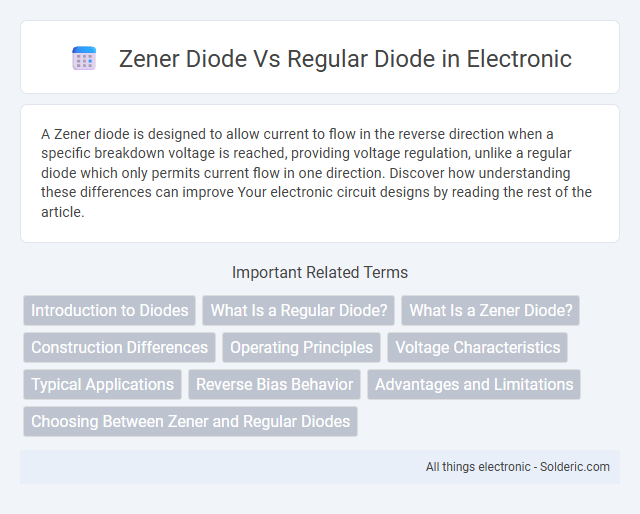A Zener diode is designed to allow current to flow in the reverse direction when a specific breakdown voltage is reached, providing voltage regulation, unlike a regular diode which only permits current flow in one direction. Discover how understanding these differences can improve Your electronic circuit designs by reading the rest of the article.
Comparison Table
| Feature | Zener Diode | Regular Diode |
|---|---|---|
| Purpose | Voltage regulation and reference | Rectification and current flow control |
| Operation Mode | Reverse breakdown region (Zener breakdown) | Forward bias conduction only |
| Breakdown Voltage | Precisely controlled and low (usually 2V to 200V) | High and not specified for breakdown |
| Symbol | Standard diode with bent edges on cathode line | Standard diode symbol |
| Applications | Voltage regulation, surge protection, voltage reference | Rectifiers, signal demodulation, switching |
| Current Flow | Allows reverse current after breakdown voltage | Allows current only in forward direction |
| Construction | Heavily doped p-n junction | Normally doped p-n junction |
Introduction to Diodes
A Zener diode differs from a regular diode primarily in its ability to allow current to flow in the reverse direction when a specific breakdown voltage is reached, known as the Zener voltage. Regular diodes primarily conduct current in one direction, blocking reverse current to protect circuits from damage. Understanding the fundamental operation of both diodes helps optimize your electronic circuit design for voltage regulation and signal protection.
What Is a Regular Diode?
A regular diode is a semiconductor device that allows current to flow in only one direction, providing unidirectional conductivity essential for rectification in electronic circuits. It operates by permitting forward bias current while blocking reverse bias current, ensuring controlled current flow. Your circuits benefit from regular diodes as they protect components by preventing voltage spikes and reverse current damage.
What Is a Zener Diode?
A Zener diode is a special type of semiconductor diode designed to allow current to flow in the reverse direction when a specific breakdown voltage, known as the Zener voltage, is reached. Unlike a regular diode that blocks current in reverse bias, a Zener diode maintains a stable and precise voltage, making it essential for voltage regulation and protection in electronic circuits. Understanding the function of a Zener diode can help you effectively manage voltage levels and safeguard your electronic devices.
Construction Differences
A Zener diode features a heavily doped p-n junction compared to a regular diode, enabling it to operate reliably in the breakdown region without damage. The increased doping results in a thin depletion region, allowing the Zener diode to regulate voltage precisely at its reverse breakdown voltage. In contrast, a regular diode has a lightly doped junction designed primarily for forward conduction and blocks current in reverse bias without controlled breakdown.
Operating Principles
Zener diodes operate based on the Zener breakdown phenomenon, allowing current to flow in the reverse direction when a specific voltage, known as the Zener voltage, is reached, providing voltage regulation. Regular diodes conduct current primarily in the forward direction and block it in reverse, except when the reverse voltage exceeds the breakdown voltage, which can damage the diode. The key operating principle difference lies in the Zener diode's ability to maintain a stable voltage in reverse bias, unlike regular diodes designed mainly for unidirectional current flow.
Voltage Characteristics
Zener diodes are designed to allow current to flow in the reverse direction when the voltage exceeds a specific breakdown voltage, known as the Zener voltage, providing precise voltage regulation. Regular diodes, by contrast, block reverse current until reaching their higher breakdown voltage, often causing damage if this threshold is exceeded. Your choice between the two depends on whether you need stable voltage control (Zener diode) or simple current rectification (regular diode).
Typical Applications
Zener diodes are primarily used for voltage regulation, providing a stable reference voltage in power supplies and protecting circuits from voltage spikes by clamping voltage at a specified level. Regular diodes are commonly employed for rectification in power conversion, signal demodulation, and polarity protection in electronic circuits. The Zener diode's ability to conduct in reverse breakdown makes it ideal for voltage stabilization, whereas regular diodes are optimized for allowing current flow in a single direction only.
Reverse Bias Behavior
Zener diodes are specifically designed to operate in reverse bias, maintaining a stable voltage across their terminals once the breakdown voltage is reached, which is crucial for voltage regulation applications. Regular diodes, in reverse bias, block current flow up to their higher breakdown voltage, risking damage if exceeded due to avalanche breakdown. The controlled breakdown feature of Zener diodes distinguishes their reverse bias behavior from regular diodes, enabling precise voltage clamping and protection in electronic circuits.
Advantages and Limitations
Zener diodes provide precise voltage regulation by maintaining a stable breakdown voltage, which makes them ideal for voltage reference and protection circuits, unlike regular diodes that primarily allow current flow in one direction. Their main advantage is the ability to clamp voltage at a specified level, offering enhanced circuit stability, but they are limited by lower current capacity and increased power dissipation compared to regular diodes. Regular diodes, while efficient for rectification and switching, lack the voltage regulation capabilities and precision of Zener diodes, restricting their use in voltage-sensitive applications.
Choosing Between Zener and Regular Diodes
Choosing between a Zener diode and a regular diode depends on your circuit's voltage regulation needs and reverse voltage requirements. Zener diodes are designed to maintain a stable voltage in reverse bias, making them ideal for voltage regulation and protection against voltage spikes, while regular diodes primarily allow current flow in one direction and protect circuits by blocking reverse current. Your choice should focus on whether you need voltage clamping and stabilization (Zener) or simple rectification and blocking (regular diode).
Zener diode vs regular diode Infographic

 solderic.com
solderic.com